1. Introduction
01 - Introduction
 With
Doom 3 on store shelves and the upcoming release of Half life 2 driving people
insane, more and more people everyday re-evaluate their need for
a VGA upgrade. All
the different brands, codenames and product families, PCI-Express or
AGP, only add to the confusion for someone trying to make a decision.
Over time and with forthcoming reviews, we will try to pinpoint and clarify
all these differences between the models and
explain
the
technologies available on the market.
With
Doom 3 on store shelves and the upcoming release of Half life 2 driving people
insane, more and more people everyday re-evaluate their need for
a VGA upgrade. All
the different brands, codenames and product families, PCI-Express or
AGP, only add to the confusion for someone trying to make a decision.
Over time and with forthcoming reviews, we will try to pinpoint and clarify
all these differences between the models and
explain
the
technologies available on the market.
In this review, we will be investigating Powercolor's
X300. The X300 is ATi's latest chipset which is designed expressly (no pun
intended) for the PCI-Express architecture.
But
what
is PCI-Express anyway?
PCI-Express is an I/O interconnect bus standard that expands
on and doubles the data transfer rates of original PCI. PCI Express is a
two-way,
serial
connection that carries data in packets along two pairs of point-to-point
data lanes, compared to the single parallel data bus of traditional PCI that
routes data at a set rate. Initial bit rates for PCI Express reach 2.5Gb/s
per lane direction, which equate to data transfer rates of approximately
200MB/s. PCI Express was developed so that high-speed interconnects such
as 1394b, USB 2.0, InfiniBand and Gigabit Ethernet would have an I/O architecture
suitable for their transfer high speeds. (Extract taken from Webopedia.com).
 In
simple terms, you'll need it if you want to install your graphics
card on your motherboard. Currently, unless your computer is more than
6 years old, your VGA card is seated in the AGP slot on your motherboard.
As today's and tomorrow's processors and Input/Output (I/O) devices demand
much higher bandwidth than AGP 8X can provide, PCI-Express was created just
for such a need with a maximum bandwidth of 16X. In the following 2 years,
AGP will be phased out
as all
VGA cards, soundcards and other peripherals will be manufactured for PCI-Express
capable motherboards. However, for the time being, PCI-Express is backwards
compatible, meaning that it still uses the same principles as PCI2.2 to
avoid application and driver problems. Due to these compatibility restriction,
an issue in performance arises since the AGP8X version of a VGA card
is currently faster than the newer PCI-E version.
In
simple terms, you'll need it if you want to install your graphics
card on your motherboard. Currently, unless your computer is more than
6 years old, your VGA card is seated in the AGP slot on your motherboard.
As today's and tomorrow's processors and Input/Output (I/O) devices demand
much higher bandwidth than AGP 8X can provide, PCI-Express was created just
for such a need with a maximum bandwidth of 16X. In the following 2 years,
AGP will be phased out
as all
VGA cards, soundcards and other peripherals will be manufactured for PCI-Express
capable motherboards. However, for the time being, PCI-Express is backwards
compatible, meaning that it still uses the same principles as PCI2.2 to
avoid application and driver problems. Due to these compatibility restriction,
an issue in performance arises since the AGP8X version of a VGA card
is currently faster than the newer PCI-E version.
Even though the X300 is aimed at the budget minded,
ATi raised the standard for low-end cards and built it using a 0.11 micron
process giving
the card some really strong points as you will see for yourself later on.
- Packaging - Bundle
The card ships in a relatively small package. Nothing fancy here, just a
plain black box wrapped in Powercolor's metallic theme. On the
front you can clearly see the card's main features, 256MB memory and 128
bit
bus along with support for DirectX 9 and OpenGL.

Inside the package you'll find as usual a DVI-I Connector, S-Video cable,
composite video cable and a printed version of the manual.
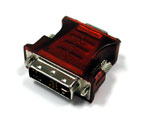
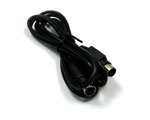
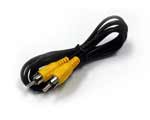
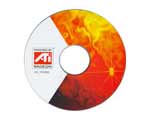
Bundled
along inside a "ProPack" cardboard cd-case is a full version
of Hitman: Contracts, a Cyberlink DVD Solution Suite (featuring Powerdirector,
Mediashow,
PowerDVD, PowerProducer DVD and Power2Go) and of course a CD with ATi's drivers
and some additional utilities

2. A closer look
02 - A closer look
| Main Features |
| GPU |
Radeon X600 - R370 |
| Memory |
256 MB 128-bit DDR1 |
| Memory Speed |
400MHz |
| Core Speed |
325MHz |
| AA Sample per Sec |
7.8 |
| Memory Bandwidth |
6.4 GB/sec |
| Pixel Pipelines |
4 |
| Shader Pipelines |
2 |
| Fill rate |
1.3 Giga pixels /sec |
| DX Support |
9.0 |
| OpenGL Support |
1.5 |
| Output |
DVI-I / TV-Out / D-Sub |
| Bus |
PCI Express |
| Processing technology |
0.11 micron |
As we mentioned earlier, the Powercolor X300 features 256MB
of DDR1 RAM, which might seem impressive to some for a low-budget card but
it's a common mistake, to opt for one VGA card over another based
purely on the amount of memory. What is more important is the chipset, the
memory bus interface (which in our case is 128 bits wide where high end cards
normally have 256 bits),
plus the fact that the memory is DDR1 and not DDR3. The memory modules
are from Mosel Vitelic which might not be such a high quality choice but
contribute to the card's relatively low price.
 |
| A close-up of a memory module. |
The X300 fully supports DirectX 9 which means you can at least
run all your favourite games with approximately the same amount of detail
as an X800 would provide.
The strange thing with the X300 is that beginning
with this card, ATi decided to introduce the first GPU chipset built using
0.11
micron
manufacturing technology. This makes the card very resistant to overheating
making it potentailly a good candidate for overclocking.
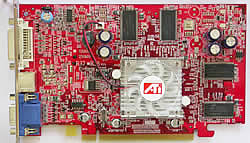 |
| The only heat protection on the
X300 is a small plastic fan. |
The card sports a red coloured PCB with it's board layout being
the same as ATi's reference. There's nothing on the card to give away its
brand, however we can see some markings indicating the card's 256MB
memory and R370 architecture.
 |
| Removing the fan and heatsink leaves the GPU exposed (click to enlarge) |
 |
Zooming in on the chipset
|
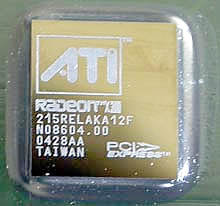 |
| Hard to do with the naked eye
but with a litle more zoom and you can read the X300 and PCI-Express
label. |
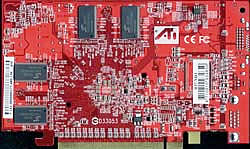 |
| The rear side of the X300 (click
to enlarge) |
3. Test System
Test System - Page 03
Processor: Retail Intel Pentium 4 530 3GHz
Case: Antec 1080AMG
Motherboard: MSI 915G Combo
Memory: 2x512MB OCZ PC-4200 Memory
Hard Disk Drive: WD800JD 80GB 7200RPM
CD-RW: LiteOn LTR-52246S
PowerSupply: Levicom 500Watt
Microsoft WindowsXP Pro Service Pack1
DirectX v9.0c
Benchmarking Software
3DMark05,03,01
Codecreatures Benchmark Pro v1.0
AquaMark3 v3.0
ATiTool 0.0.22
Farcry v1.1 Build 1256
CounterStrike Source Beta
Doom 3
Medal of Honour Pacific Assault Demo
Thief 3
Ground control II
One more thing to note about the tests, is
that since we changed our CPU and motherboard and this is our first PCI-Express
review,
we will not be comparing this card with any others.
Also, you might notice that we've updated the list of benchmarks,
since some games were either obsolete for benchmarking or just not so popular.
4. 3DMark05
3DMark05 - Page 04
 With 3DMark05, Futuremark continues the tradition in its benchmarking software by providing a state-of-the-art Microsoft ® DirectX ® 9 3D performance benchmark.
With 3DMark05, Futuremark continues the tradition in its benchmarking software by providing a state-of-the-art Microsoft ® DirectX ® 9 3D performance benchmark.
3DMark05 is an all new 3DMark version taking the most out of Microsoft's DirectX
9. The previous version 3DMark03, did a nice introduction into this level
of technology. However 3DMark03 used DirectX 9 specific features in a limited
manner, because fully supporting  hardware
was rare at the time of its launch. In contrast, 3DMark05 requires DirectX
9 hardware with full support for at least Shader Model 2, and takes shader
usage to never before seen levels.
hardware
was rare at the time of its launch. In contrast, 3DMark05 requires DirectX
9 hardware with full support for at least Shader Model 2, and takes shader
usage to never before seen levels.
Just like its predecessors, 3DMark05's point system is set so that at the moment
of release, the high-end VGA cards available in stores can only score around
5000 3DMarks, whereas the worst card that meets the programs requirements yields
a score of 1000.
Game Test 1 - Return to Proxycon
Being the sequel to the "Battle of Proxycon" from
3DMark03, in "Return to Proxycon" we're
once again set in space and the battle continues as space pirates invade
a cargo ship in order to take control of its valuable cargo.

This test tries to simulate a future first-person shooter
game with all the high details that it entails. The dynamic shadows, high-detailed
environment and advanced lighting techniques ensure that under normal circumstances,
no recent card can run it with decent frame rates.

The framerates on the first test of the 3DMark05 are really
low in comparison to GT1 in 3DMark03, where a typical card would get more
that
200+ fps. Still, the X300 performed suprizingly better than the 9600pro.
Game Test 2 - Firefly Forest
A forest gets filled with magic fireflies in the night. The moon is nearly full, illuminating the forest with a bluish faint light. The magic fireflies have flickering bright green lights that playfully move around the forest.
This scene is a nice example of a smaller scale outdoor scene with rich vegetation. Immediate visibility is not so far, and there is a skybox surrounding the whole scene.

A large number of trees with their branches swinging separately, and dense vegetation being dynamically distributed according to the camera movements, make this test the most demanding of the three.

With only a negligible difference of 0.2 between them, we can
only conclude that the two cards are equally slow...
Game Test 3 - Canyon Flight
A Jules Verne type airship flies through a canyon guarded
by a dangerous sea monster. The airmen defend their ship using heavy cannons,
but these seem to have no effect on the huge sea monster.
Finally the crew manages a narrow escape using the "last resort" afterburners
of the airship.
This scene is fairly complex with large areas of
water reflecting the high canyon walls. The water actually is one of the key points of interest in this scene.
The water not only does realistic looking reflections and refractions, it has a depth fog, making the sea
monster swimming under the airship actually look deep down in the water. The air in this scene also uses
a volumetric fog, making distant cliffs of the canyon really look far away.

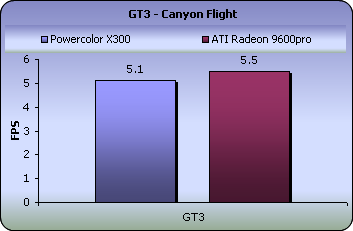
The X300 performed slightly slower than the 9600pro. This
game test is the lighter, yet most impressive of the three and hence the
higher framerates.
Final Score
3DMarks on 3DMark05 are now calculated by the following formula:
(Game Test 1 * Game Test 2 * Game Test 3)^0.33 * 250
That's basically the geometric mean of the total frames in
each game multiplied by 250. That means that all game tests are now equal.
Let's see our result for the X300:
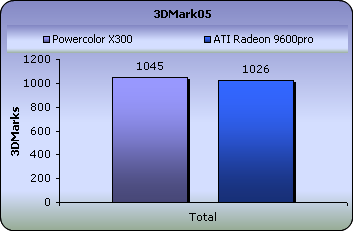
The conclusion depends on your way of looking at the scores.
According to Futuremark, 1000 3dmarks is the minimum score you'll ever get
with a videocard on 3DMark05. In which case the X300's 1045 points
are a bit disappointing. On the other hand though, its score is at the same
level
as
the 9600pro. Maybe
some older benchmarks with a wider range of scores will provide us with a
clearer indication.
5. 3DMark 2003
05 - 3DMark 2003
 3D Mark is a widely used and accepted benchmark that stresses the DirectX performance of a VGA card. A very strong point of 3DMark is that it's VGA card measuring is does not require any CPU power. So the resulting fps are a good reference of a VGA card's rendering performance. For testing the performance of each card we used the 4 game benchmarks 3DMark has.
3D Mark is a widely used and accepted benchmark that stresses the DirectX performance of a VGA card. A very strong point of 3DMark is that it's VGA card measuring is does not require any CPU power. So the resulting fps are a good reference of a VGA card's rendering performance. For testing the performance of each card we used the 4 game benchmarks 3DMark has.

|
- Game Test 1 - Wings of Fury (DX7)
This test is a combat flight simulator written for older hardware (DirectX 7). Particles are used a lot in this test - smoke and vapor trails, flak and gunfire, and explosions are produced using point sprites and quads.
|

|
- Game Test 2 - Battle of Proxycon (DX8)
This test is a simulation of first person shooter game types. 1.1 and 1.4 Vertex
shaders are widely used since all character models are skinned using vertex
shaders. This makes this test a good vertex shader comparison for VGA cards.
|

|
- Game Test 3 - Trolls' Lair (DX8)
This test should be the favorite of all RPG lovers. It is a cut scene of a female warrior facing two malicious trolls. Again the same vertex and pixel processing is used as in game test 2.
This test also uses post-processing effects, such as Depth of Field and Bloom effects which are widely used in today's game cut scene sequences.
|

|
- Game Test 4 - Mother Nature (DX9)
Mother nature represents the level of effects and realism that are possible using 2.0 vertex and pixel shaders, plus some other features that DirectX 9 offers.
|
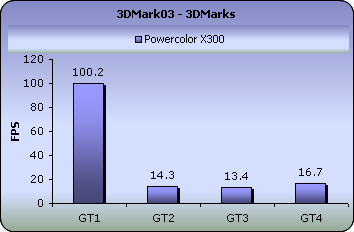
- 3DMark Official score
If you test your machine with 3DMark, you can post the results
at 3DMark's online result browser. For more information visit futuremark.com.
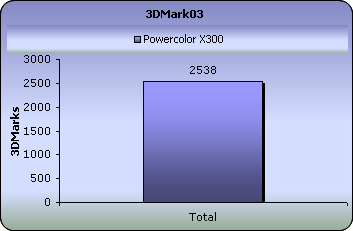
The total score, widely known as 3DMarks, is an immediate result
of the framerates the games where run under. Not too bad of a result but we
did expect more from the X300.
6. 3DMark 2001
06 - Aquamark3 / 3DMark 2001
 Since
the majority of today's applications and games are compatible with DirectX
9, the need for benchmark applications that use DX 9 has been brought up.
The benchmark uses the 3D engine (Krass engine) of the Aquanox game.
Since
the majority of today's applications and games are compatible with DirectX
9, the need for benchmark applications that use DX 9 has been brought up.
The benchmark uses the 3D engine (Krass engine) of the Aquanox game.
Aquamark Triscore
The Aquamark Triscore comprises 3 values: the overall system performance, the performance of the graphics system and the CPU performance. Keep in mind that this is not the total result of the tests, but the result of the whole benchmark process including all 9 chapters.

3DMark 2001
3DMark 2001 is the predecessor to 3DMark03. It's mainly
a directx8.1 benchmark and the score depends a lot on the CPU power of
your computer. However for reference use only we decided it'd be best to
just leave it in our benchmark list so you can compare the next generation
cards with the possibly outdated one you have at home.
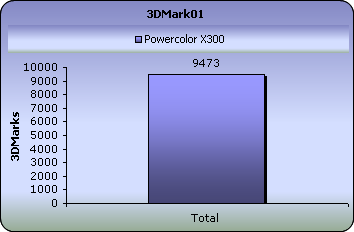
7. Codecreatures
07 - Codecreatures
 CodeCreatures is a synthetic 3D benchmark that is a good reference for VGA performance comparison. This is a high-end 3D benchmark that also requires DirectX 8 hardware, making a good tool for measuring the potential of DirectX 8 game performance.
CodeCreatures is a synthetic 3D benchmark that is a good reference for VGA performance comparison. This is a high-end 3D benchmark that also requires DirectX 8 hardware, making a good tool for measuring the potential of DirectX 8 game performance.
The Codecreatures benchmark is written with Microsoft's DirectX 8.1 API and incorporates the use of Vertex and PixelShaders popular on next generation 3D accelerators.
 The benchmark plays a photo-realistic nature scene and calculates the performance of the graphics adapter by measuring the fps that it can display at 1024x768, 1280x1024 and 1600x1200 resolutions. The score is a geometric mean of those three resolutions called the Codecreatures number.
The benchmark plays a photo-realistic nature scene and calculates the performance of the graphics adapter by measuring the fps that it can display at 1024x768, 1280x1024 and 1600x1200 resolutions. The score is a geometric mean of those three resolutions called the Codecreatures number.
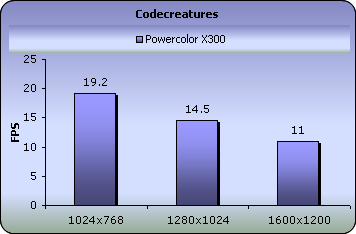
-Codecreatures number
The codecreatures number is the resultant score of the total
benchmarking process which includes some other measures except from a plain
sum up of the fps results.
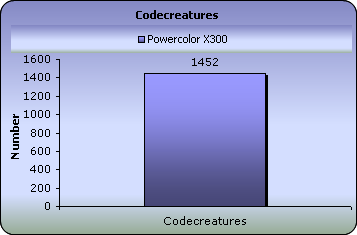
The X300 produced a quite low codecreatures number as it couldn't
run any of the tests at a satisfactory level.
8. Half life 2
08 - Half life 2
Half life 2 is no doubt the most anticipated pc game of
all time. Gamers keeping the excellence of Half Life 1 in their mind as
well as the remarkable E3 demo preview, have been anxiously waiting for
the much delayed release of HL2.
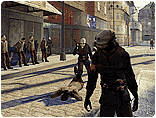 Regarding the storyline, the player again picks up the crowbar of research scientist Gordon Freeman, who finds himself on an alien-infested Earth being picked to the bone, its resources depleted, its populace dwindling. Freeman is thrust into the unenviable role of rescuing the world from the wrong he unleashed back at Black Mesa. And a lot of people he cares about are counting on him.
Regarding the storyline, the player again picks up the crowbar of research scientist Gordon Freeman, who finds himself on an alien-infested Earth being picked to the bone, its resources depleted, its populace dwindling. Freeman is thrust into the unenviable role of rescuing the world from the wrong he unleashed back at Black Mesa. And a lot of people he cares about are counting on him.
 Characters - Advanced facial animation system delivers the most sophisticated in-game characters ever seen. With 40 distinct facial "muscles," human characters convey the full array of human emotion, and respond to the player with fluidity and intelligence.
Characters - Advanced facial animation system delivers the most sophisticated in-game characters ever seen. With 40 distinct facial "muscles," human characters convey the full array of human emotion, and respond to the player with fluidity and intelligence.
Physics - From pebbles to water to 2-ton trucks respond as expected, as they obey the laws of mass, friction, gravity, and buoyancy.

Graphics - Source's shader-based renderer, like the one
used at Pixar to create movies such as Toy Story® and Monster's, Inc.®,
creates the most beautiful and realistic environments ever seen in a video
game.
AI - Neither friends nor enemies charge blindly into the fray. They can assess threats, navigate tricky terrain, and fashion weapons from whatever is at hand.
To measure performance we used the Video Stress Test (VST)
that is available in the CounterStrike:Source beta available through Steam.
We set all the details to the highest level and changed the resolutions from
800x600 to 1600x1200.
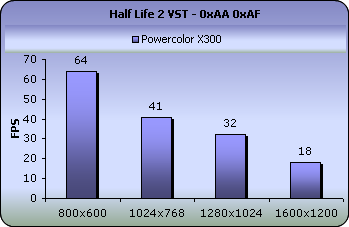
The average frame rate in the HL2 Video stress test probably
won't represent actual half life 2 gameplay, but still our X300 performed
satisfactorily in the test. What you can't see here is that below 1024x768,
the minimum fps
we got was 21 when passing through the rotating glass mirrors.
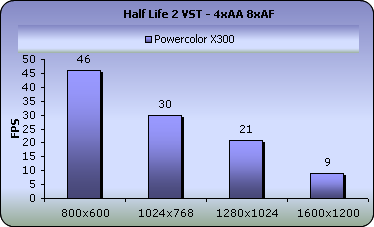
Enabling the AA and AF quality options, we got a very small
drop in performance. Even though you shouldn't expect the X300 to render
half life 2 well, it managed to keep the framerate above 25 even at
1024x768.
Don't forget, the x300 is here to replace the 9200 which didn't even support
DirectX 9 effects.
9. Doom 3
09 - Doom 3

A massive demonic invasion has overwhelmed the Union Aerospace Corporations? (UAC) Mars Research Facility leaving only chaos and horror in its wake. As one of the few survivors, you struggle with shock and fear as you fight your way to Hell and back, in an epic clash against pure evil.
Activision made it's miracle again with Doom 3 which is said to be the best-looking game ever, thanks to the brand-new OpenGL graphics engine used to generate its convincingly lifelike, densely atmospheric, and surprisingly expansive environments. If you are a fan of the previous Doom games then you will get many flashbacks with this revision, since you will find reimagined versions of almost every monster from both Doom and Doom II.
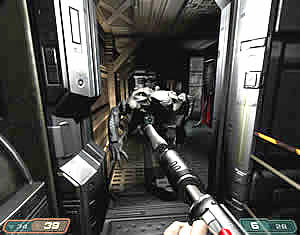
To measure performance with the game we used the timedemo
demo1 command from the console (Alt+Ctrl+~). Enabling the high quality setting
and executing the timedemo demo1 command twice for each resolution, I witnessed
the following:
First without the Anti-Aliasing and Anisotropic Filtering settings enabled we got the following results:

Even though we did all the necessary optimizations to keep
the framerate as high as possible, it seems that wasn't enough. Unfortunately,
the X300 can't handle Doom's new engine with all its settings set to high.
Maybe some overclocking might do the job later on.
Let's try to enable Anti-Aliasing and Anisotropic Filtering. You can already guess the results will be dramatic but nevertheless it's interesting to see how much it affects our framerates.
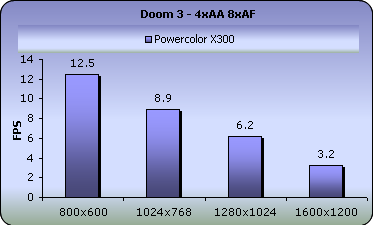
Once again our fps dropped to half of their previous values. This is not
a good sign since most VGA cards exhibit a decrease of 20-30%. However
we shouldn't forget that the card is targeted at the low-end VGA market
and the
low-end
VGA market last time we checked, doesn't ever get to use AntiAliasing anyway.
Let's move on to Far Cry.
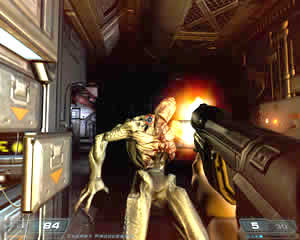
10. Far Cry
10 - Far Cry

 You are Jack Carver running your own boat charter business in beautiful Micronesia. With a past best left behind you, you'll be focusing on your present assignment: escorting an ambitious journalist named Valerie Cortez to the Island of Cabatu. It seems like a piece of cake, but you'll soon learn: paradise can be hell.
You are Jack Carver running your own boat charter business in beautiful Micronesia. With a past best left behind you, you'll be focusing on your present assignment: escorting an ambitious journalist named Valerie Cortez to the Island of Cabatu. It seems like a piece of cake, but you'll soon learn: paradise can be hell.
Farcry is an awesome First Person Shooter (FPS) based on a last generation 3D engine named as CryEngine. Real-time editing, bump-mapping, static lights, network system, integrated physics system, shaders, shadows and a dynamic music system are just some of the state of-the-art features that the CryEngine offers.
A great advantage and strong point of the CryEngine is its physics system which supports character inverse kinematics, vehicles, rigid bodies, liquid, rag doll, cloth and body effects. All physics seem to be very realistic and you never get bored when facing enemies, since character models have multiple animations that blend in believable ways.
With an integrated shader system and a massive terrain which maximizes the view distance to 2km these features make Farcry a perfect action game and also a referable benchmark to speak of.
- Benchmark Settings
For this game, we recorded a new demo from the start of the Rebellion
stage. We chose an indoor scene in order to avoid being CPU bound under any
circumstances. This will produce slightly higher results since it is also less
GPU intensive but we can't afford being stuck at 40-50 fps because of CPU
limitations.
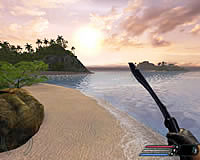
The latest patch (1.2) was used for our tests which updates the game's graphics engine to use the Shader model 3.0. Unfortunately this is supported for the 6800 series only.
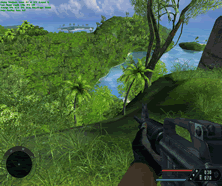
The resolutions we ran the demo at are the following: 800x600,1024x768,
1280x1024 and 1600x1200. The first test was committed with Anti Aliasing (AA)
and Anisotropic Filtering (AF) features off. In the second test we leveled
up AA at 4x and AF at 8x.

Can you believe that? Excellent performance! We'd never expect
ATI's latest low-end chipset to be able to handle such a graphically intense
game as Far Cry with all its eye candy settings enabled. The result is really
stunning. We couldn't believe our eyes so we checked our settings one more
time to make sure we had set everything correctly. Far Cry is actually playable
under 1024x768! Of course, don't expect the framerate to be above 25 at all
times but it's not something you can't sacrifice for a higher resolution.

Enabling 4x Anti-aliasing and 8x Anisotropic Filtering halved
the framerates we got when we had these set to off. The results are once again
suprizingly high for our card. We thought the X300 was made for office applications
and we were totally wrong.
11. Medal of Honour Pacific Assault
11 - Medal of Honour Pacific Assault
 Medal
of Honor Pacific Assault puts you in the boots of a WWII soldier in the
Pacific Theatre of Operations. As Marine Private Tommy Conlin, you
Medal
of Honor Pacific Assault puts you in the boots of a WWII soldier in the
Pacific Theatre of Operations. As Marine Private Tommy Conlin, you 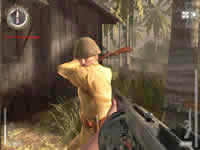 must
survive the devastating attack on Pearl Harbor and then join the Allied
crusade to defeat imperial Japan's bloody conquest of the Pacific. From
the attack at Pearl Harbor to the pivotal battle against Japanese Forces
at Tarawa Island, Medal of Honor Pacific Assault gives PC gamers a sense
of the courage it took to endure and overcome the Japanese threat in WWII
and fight for VICTORY in the Pacific.
must
survive the devastating attack on Pearl Harbor and then join the Allied
crusade to defeat imperial Japan's bloody conquest of the Pacific. From
the attack at Pearl Harbor to the pivotal battle against Japanese Forces
at Tarawa Island, Medal of Honor Pacific Assault gives PC gamers a sense
of the courage it took to endure and overcome the Japanese threat in WWII
and fight for VICTORY in the Pacific.
To record performance with this game we used fraps and
played around for a minute in the first stage of the demo.

The Powercolor X300 unfortunately couldn't handle all the details
"Medal of honour: Pacific Assault" has to offer and that shows on the graph.
It was nearly impossible to play at the 1280x1024 resolution and gameplay
wasn't even smooth at 800x600.
We couldn't set any AntiAliasing at this point so we'll just present the plain result until we get the full game version.
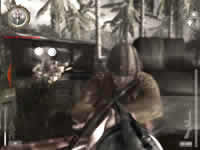
12. Thief 3
12 - Thief 3
 Instead
of Deus Ex from now on we'll be testing our cards using Thief 3. It's based
on the same engine but it's much less GPU intensive and playable by more
VGA cards than Deus.
Instead
of Deus Ex from now on we'll be testing our cards using Thief 3. It's based
on the same engine but it's much less GPU intensive and playable by more
VGA cards than Deus.
The game makes severe use of Pixel Shader 1.1 instructions, the bloom  effect and stencil shadows to achieve a wonderful result in your screen.
effect and stencil shadows to achieve a wonderful result in your screen.
In the game you play the part of Master Thief Garrett who is back to rule out any evil forces using his unique stealth abilities. Deadly Shadows shows what stealth gameplay is all about. This game really gives you the feel of sneaking around and holding your breath when stuck in a sticky situation.
Since there is no official benchmark for the game, we'll do our tests
using a GPU intensive scene from the tutorial-level which we believe that
represents the average fps you'll get when playing the game.
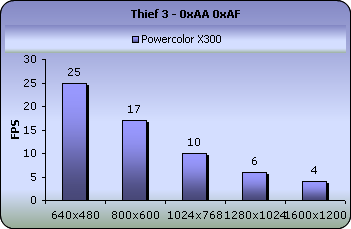
The X300 had a hard time rendering this really graphically heavy game. At
640x480 the game is barely playable.
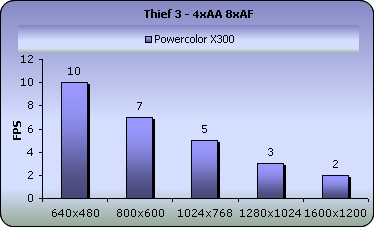
Since Thief 3 is based on Deus Ex's engine, there is no support for Anti-Aliasing
but instead it uses Multisampling technology which is something similar. That
way, we set Multisampling to 4x and Anisotropic filtering to 8x through ATI's
control panel. The resulting scores are a disaster. We could almost count the
frames without the use of a program!
13. Colin McRae 05
13 - Colin McRae 05
 For all you racing fans out there, this test is for you and will represent the Racing game category in our benchmarks.
For all you racing fans out there, this test is for you and will represent the Racing game category in our benchmarks.
From a graphics point of view, the first thing you'll
notice in the game is the excellent amount of detail of your racing car.
High resolution textures on the car and lighting make it quite impressive.
All
the eye candy such as the sun reflection in the virtual camera are still
the same as the older CM versions but motion blur has been added when your
car hits something hard which will happen most often if you're new to
the racing simulation world.
To measure performance with the game we used fraps to
get the average fps of the whole 8th stage of UK which is actually the
only
stage you get to play on the demo.
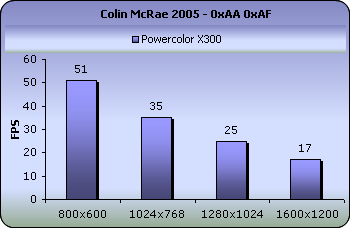
You can see the game has acceptable performance at 800x600
and 1024x768 but when moving to higher resolutions, gameplay gets more difficult.
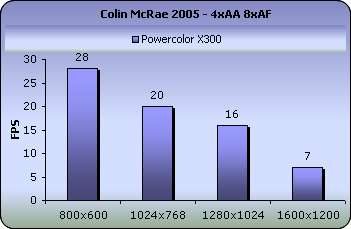
Enabling the standard quality settings is out of the question
for this one. Even though under 800x600 the average fps is above 25, it dropped
more than once below that limit making our gameplay a bit annoying.
14. Ground Control II
14 - Ground Control II
 Ground
Control 2 is an action-oriented game of tactics and warfare. As Captain Jacob
Angelus of the Northern Star Alliance, you will command squads of infantry,
artillery, and airpower against the might of the Empire of Terra. Base building
and
Ground
Control 2 is an action-oriented game of tactics and warfare. As Captain Jacob
Angelus of the Northern Star Alliance, you will command squads of infantry,
artillery, and airpower against the might of the Empire of Terra. Base building
and 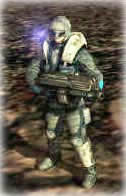 resource-collecting
are replaced with unit control and combat tactics where your knowledge of
the battlefield maneuvers will make the difference in your fight against
a ruthless enemy. Position your troops on hilltops for better aim or inside
buildings and forests for protection as you'll need to use every inch of
terrain to your advantage. Call in air strikes or assault pods to bring the
battle
behind enemy lines. Send out scouts to locate the enemy and use spotters
for your artillery with the 360° free-roaming camera. Experience the total
immersion of futuristic warfare as you lead your forces to victory!
resource-collecting
are replaced with unit control and combat tactics where your knowledge of
the battlefield maneuvers will make the difference in your fight against
a ruthless enemy. Position your troops on hilltops for better aim or inside
buildings and forests for protection as you'll need to use every inch of
terrain to your advantage. Call in air strikes or assault pods to bring the
battle
behind enemy lines. Send out scouts to locate the enemy and use spotters
for your artillery with the 360° free-roaming camera. Experience the total
immersion of futuristic warfare as you lead your forces to victory!
For our benchmarks we used the highest possible settings on the first mission of the single player game, moved around the camera and got an average framerate using fraps.
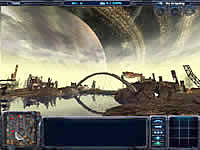
Ground Control II offers really impressive graphics without requiring much GPU power. Click on the picture above to view a screenshot from the game. Check out the excellent water effects!
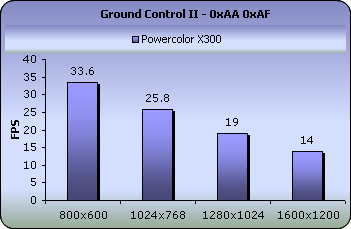
The 33.6 fps we got at 800x600 make it the best setting to play this
game along with 8x Anisotropic filtering enabled. Moving to 1024x768 is still
possible
but don't expect very smooth gameplay.
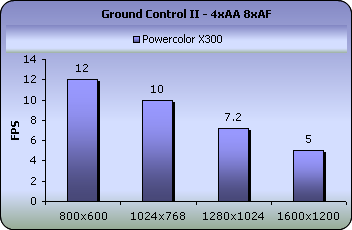
Enabling 4xAA and 8xAF in this game is out of the question with this card. You can see for yourself how low the results are.
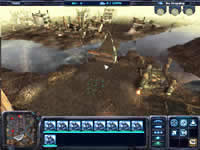
15. Overclocking
15 - Overclocking
Before we start, here's a little note: Don't try to do this at home unless
you are completely sure of what you are doing. It might sound a bit cliche
but believe me, the kind of overclocking that you are about to see can't be
done with any kind of VGA card.
Normally, you can clock most cards using their stock cooling system from 25
to at most 100 MHz over their default speeds for core and memory. From that
point on, you either get strange sand-like effects or other anomalies on your
screen (called artifacts) or between some short amounts of time the whole game
pauses for 2-3 secs.
The first case is a sign that you have pushed your memory clock speed beyond
its limits and the second is that the core's clock is the one that is set too
high. In both cases, you should lower the clocks until you experience none
of these effects for 10-15 minutes of intense gameplay.
Here comes Powercolour's X300 to become the exception to the rule.
It's stock speeds were 320Mhz for the core and 400Mhz for the memory.
Using AtiTool, we managed to clock this card to 500MHz for the core and 490MHz
for the memory!!! It's simply an insane amount of overclocking.
But the most insane thing we saw is yet to come.
Most cards when overclocked, get an average boost of 5 fps on the games.
We pushed this baby again to 500/490 and ran our Half Life 2 Video Stress Test
and Doom 3 benchmarks:
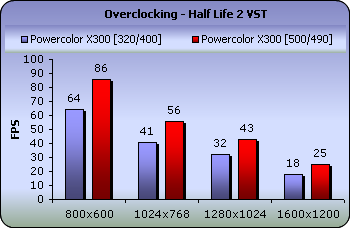

That was too much to believe. 22 more frames per second on
the Video Stress Test for Half Life 2. We ran the two benchmarks one more time
to
make sure we were not mistaken but we got the same results. Then we ran our
Far Cry benchmark.
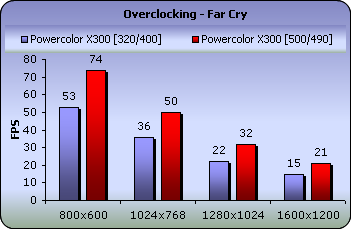
21 frames more at 800x600 and 14 at 1024x768.
This time we knew nothing went wrong. It's just that this card is born with
a mysterious overclocking potential.
The funniest part is that it has no heatsinks on its RAM modules
and its only method of cooling the GPU core is this little fan:

I'm sure you'll agree with us as we present the Powercolor
X300 with our Overclocker Award for this year.
16. Conclusion
16 - Conclusion

We're still shocked about Powercolor's X300 overclocking abilities. Not only
did we get to set the clocks at a very high level while maintaining stability,
but the performance increased accordingly contrary to our expectations.
Always keeping in mind that the X300 is here to substitute the 9200 and 9600SE
for the PCI-Express slot, we must admit it did a great job. Powercolor's X300
is
not a port from any older card, its architecture is new and that shows on games
like Far Cry and Doom 3. It's hard to believe that the future low-budget systems
will be able to play Far Cry with little problems where even the Fx5900 had
trouble rendering.
This card costs around US$130-140 which might be one of the priciest of
the budget market but it's still not a lot to spend given it's performance.
As for the software bundle, it's not too exciting but not too bad either. Hitman
contracts might not be the game you were planning to buy but it's still better
than any other mediocre game some other cards might give you or even nothing
at all.
Pros:
-Extreme overclocking potential
-Nice performance for its class
-Reasonable price
-Silent operation
Cons:
-Lower quality memory modules
Performance: |
|
Value for money: |
|
Overclocking: |
|
Bundle: |
|